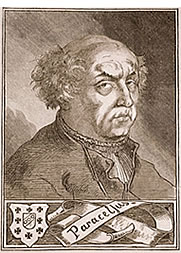All
Mankind
Is One.
All
Mankind
Is One?
By Dr. Ronald Fritze
December 10, 2007
"They saw naked people."
— The first mention of human beings in Columbus's Diario
after the discovery of San Salvador island on 12 October 1492
"It is easy to see how much better it is
that God was pleased to produce the human race
from the one individual he created,
than if He had originated it in several men . . . .
And indeed He did not even create the woman
that was given him [Adam] as his wife,
as He created the man,
but created her out of the man,
that the whole human race might derive from one man."
— St. Augustine, City of God, bk. 12, ch. 21
 Father Bartolome de Las Casas (1474/84-1566),
the great defender of the Native Americans, insisted that the aboriginal inhabitants of the Americas were fully a part of the human race and potentially the spiritual equals of Europeans. It was not a position that was universally accepted by his contemporaries or those who followed. Just as Las Casas could confidently assert that "All mankind is one," there were doubters who used the same words to ask the question, "All mankind is one?"
Father Bartolome de Las Casas (1474/84-1566),
the great defender of the Native Americans, insisted that the aboriginal inhabitants of the Americas were fully a part of the human race and potentially the spiritual equals of Europeans. It was not a position that was universally accepted by his contemporaries or those who followed. Just as Las Casas could confidently assert that "All mankind is one," there were doubters who used the same words to ask the question, "All mankind is one?"
A Nice, Neat Cosmology Disintegrates.
Columbus's unintended revelation
of the existence of the Americas in 1492 began the disintegration of the medieval European worldview. Medieval Christendom had a nice, neat cosmology that explained virtually every aspect of human existence. God created Adam and Eve, who began to procreate and people the earth. When humanity proved evil, God destroyed it with the universal Flood. Only Noah and his wife along with their three sons Shem, Ham, and Japheth and their wives were saved in the great Ark. These survivors began the repopulation of the world. Each of the sons was associated with one of the three known continents — Ham with Africa, Shem with Asia, and Japheth with Europe (albeit the massive Europe of the ancient world that included Siberia and the Far East). All humans were descended from the three sons of Noah.
The Native American represented a problem.
How did they fit into this scheme, along with the two hitherto unknown continents that they inhabited? The previous, tidy schema of Medieval Europe was shattered.
There is a joke that recounts
George Armstrong Custer's last words at Little Bighorn: "Where did all these Indians come from?" Spanish chroniclers and missionaries asked the same question centuries earlier — and it has been asked ever since, because we really do not know when and how the Americas were peopled.
How and When Did the People Get There?
One theory contends that some,
if not most of the ancestors of the aboriginal Americans came over the Bering land bridge. Others suggest that voyages across the Atlantic and/or the Pacific Oceans might have occurred in the very distant past. Some people have suggested that the first humans reached the Americas over 100,000 years ago, although that speculation is not widely accepted.
Recently, however, several archaeological sites
have yielded remains that radio-carbon date back to 40,000 years ago, which is far earlier than the current consensus of humans arriving in the Americas around 15,000 to 20,000 years ago. Whether these earlier dates are good ones or are the result of contamination is the subject of hot debate among scholars.
Scholars and thinkers of the sixteenth
and seventeenth centuries were just as passionate about their theories of the peopling of the Americas. Some suggested Atlantean refugees were the ancestors of the Native Americans. Others proposed that the Ten Lost Tribes of Israel had settled in the Americas (see my essay Ancient Hebrews in Ohio?) — and if not the Lost Tribes, then some other band of wandering Hebrews or Jews. Phoenicians and ancient Spaniards also joined the ranks of the supposed first inhabitants of the Americas. Somehow they all must have come to the Americas sometime after Noah's flood because it inundated the entire earth and drowned everyone but Noah and his family.
Paracelsus, Polygenesis, and Two Adams.
 The problem with linking
the Native Americans to descent from Noah is that it just did not give people enough time to migrate the vast distances to the Americas and then establish the great civilizations of Mexico and Peru. This circumstance caused some people to suggest the possibility of polygenesis, i.e., that God had engaged in more than one creation. Paracelsus [Theophrastus Bombastus von Hohenheim (1493-1541)], a Swiss-German physician and alchemist of wide-ranging interests, suggested the idea of double-Adamism:
The problem with linking
the Native Americans to descent from Noah is that it just did not give people enough time to migrate the vast distances to the Americas and then establish the great civilizations of Mexico and Peru. This circumstance caused some people to suggest the possibility of polygenesis, i.e., that God had engaged in more than one creation. Paracelsus [Theophrastus Bombastus von Hohenheim (1493-1541)], a Swiss-German physician and alchemist of wide-ranging interests, suggested the idea of double-Adamism:
I cannot refrain from making a brief mention of those who have been found in hidden islands [the lands discovered by Columbus] and are still little known. To believe that they have descended from Adam is difficult to conceive — that Adam's children have gone to hidden islands. But one should well consider, that those people are from a different Adam. It will be difficult to maintain, that they are related on the basis of flesh and blood.
God created one Adam
for the Eastern Hemisphere and another Adam for the Western Hemisphere!
Others such as Christopher Marlowe
and Giordano Bruno began to toy with the old idea that God had created some humans before Adam. Furthermore, it was suggested that the Flood had not destroyed the people living in the Americas.
The Radical Biblical Viewpoint of La Peyrere.
Ultimately a French Protestant
named Isaac de La Peyrere (1594-1676) produced in the form of two books published in 1655 a full-fledged argument for the existence of pre-Adamic peoples. His writings certainly helped to explain the Native Americans. La Peyrere asserted that only the Jews were descended from Adam. All other humans came from pre-Adamite ancestors — for La Peyrere, this was not an important distinction because, ultimately, all people would be saved.
La Peyrere arrived at his theory of pre-Adamism
by treating the Bible as a scholarly text like any other from the ancient canon. In taking this approach, La Peyrere was helping to create the modern study of the Bible through higher criticism. Indirectly, the discovery of the Americas prompted this entire process. Nor were La Peyrere's ideas about pre-Adamism stillborn, even though he was charged with heresy and forced to write a retraction.
New Uses for an Old Concept.
Pre-Adamism survived through the Enlightenment
of the eighteenth century. During the nineteenth-century, the concept acquired new uses. Some scholars used pre-Adamic races to help explain the process of human evolution in a way that could also incorporate the creation of Adam in God's image relatively recently in the history of the earth. Others used pre-Adamism to justify black slavery and white supremacy both before and after the Civil War. By the mid-twentieth century, extreme right-wing racists incorporated the concept that negroes were the lowest in the hierarchy of pre-Adamic races into the theology that is associated with Christian Identity.
Amazingly, in this modern manifestation,
it all started with Columbus!
Christopher Columbus and the Great Age of Discovery
HIST 351 ~ Fall 2007
|

